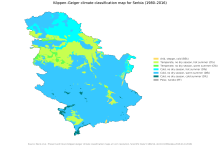
The climate of Serbia is between a continental climate in the north, with cold dry winters, and warm, humid summers with well distributed rainfall patterns, and a more Mediterranean climate in the south with hot, dry summers and autumns and average relatively cool and more rainy winters with heavy mountain snowfall. Differences in elevation, proximity to the Adriatic Sea and Aegean Sea and large river basins, as well as exposure to the winds account for climate differences.[1]
Most of Northern Serbia possesses a typical continental climate, with air masses from northern and western Europe which shape its climatic profile. South and South-east of Serbia is subject to strong Mediterranean influences (hotter summers and milder winters). However, the Dinaric Alps and other mountain ranges contribute to the cooling down a large part of the warm air masses. Winters are quite harsh in Raška (region) because of the mountains which encircle the plateau.[2] One of the climatic features of Serbia is Košava, a cold and very squally southeastern wind which starts in the Carpathian Mountains and follows the Danube northwest through the Iron Gate where it gains a jet effect and continues to Belgrade and can spread as far south as Niš.[3] Mediterranean micro-regions exist throughout southern Serbia,[4] in Zlatibor[5] and the Pčinja District around valley and river Pčinja.[6]
The average annual air temperature for the period 1981–2017 for the area with an altitude of up to 300 m (984 ft) is 11.6 °C (52.9 °F). The areas with an altitude of 300 to 500 m (984 to 1,640 ft) have an average annual temperature of around 11.0 °C (51.8 °F), and over 1,000 m (3,281 ft) of altitude around 7.5 °C (45.5 °F).[7]
- ^ "Serbia :: Climate". Encyclopædia Britannica Online. 2007. pp. 5 of 71.
- ^ Radovanović, M and Dučić, V, 2002, Variability of Climate in Serbia in the Second Half of the 20th century, EGS XXVII General Assembly, Nice, 21 April to 26 April 2002, abstract #2283, 27:2283–, provided by the Smithsonian / NASA Astrophysics Data System
- ^ "Kossava". Glossary of Meteorology, Second Edition. American Meteorological Society. June 2000. Archived from the original on 30 September 2007. Retrieved 11 March 2007.
- ^ "The World Factbook". Cia.gov. Retrieved 2016-04-14.
- ^ "RPK Uzice - TOURISM IN ZLATIBOR REGION". Archived from the original on March 15, 2012. Retrieved November 30, 2010.
- ^ "River Pčinja Valley | Travel 2 Serbia". Archived from the original on September 18, 2009. Retrieved February 10, 2010.
- ^ "Basic Climate Characteristics for the Territory of Serbia". Republic Hydrometeorological Service of Serbia. Archived from the original on 2017-10-10.